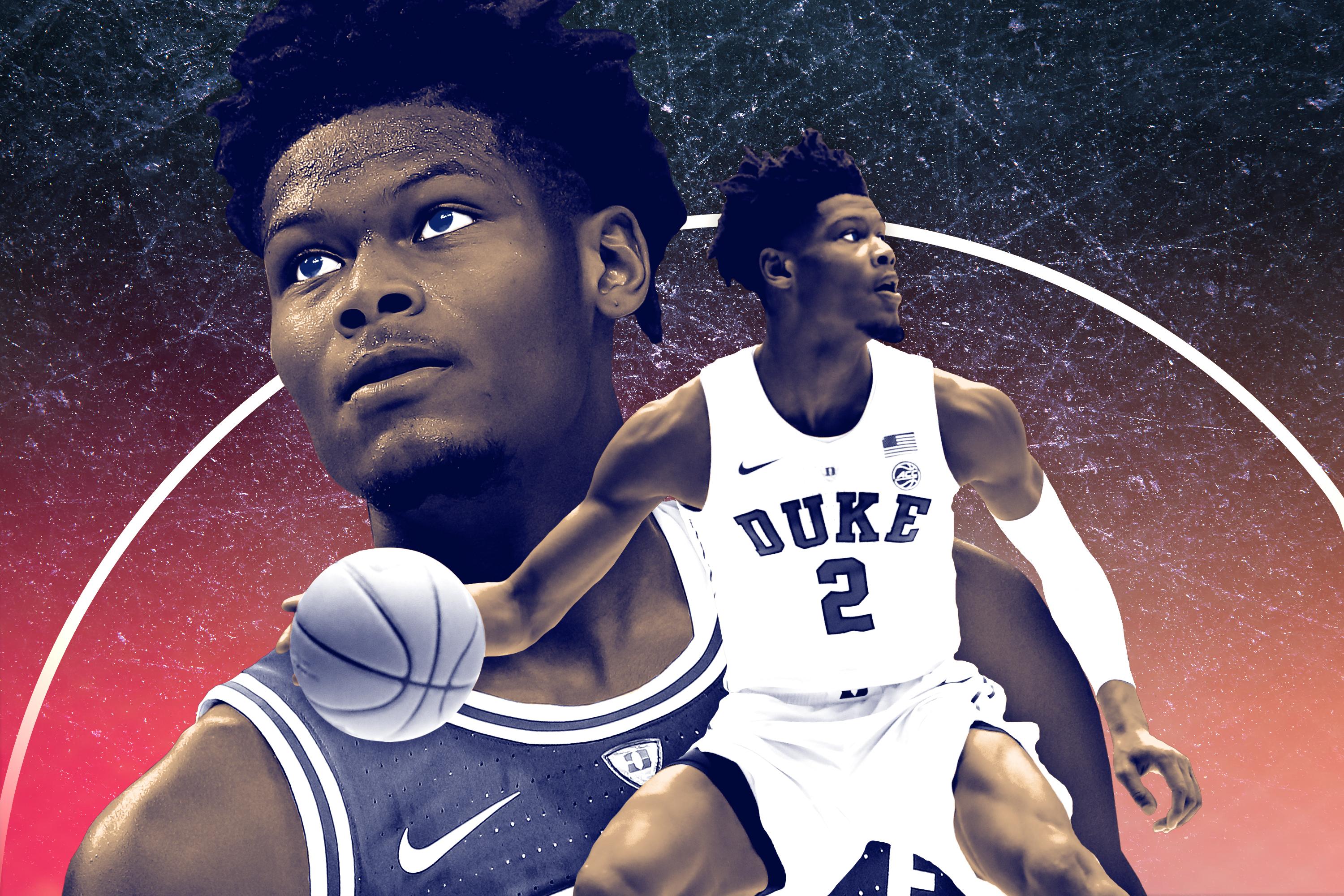Cam Reddish Is Duke’s (and the Draft’s) Biggest Enigma
It’s been a brutal adjustment period for the Blue Devils’ third star freshman, but come June, it might not matter. He is still a model of what lies ahead for the 3-and-D swingman archetype.
Not much has gone right for Cam Reddish in his first few months at Duke. He has struggled to adjust to a smaller role behind fellow freshmen R.J. Barrett and Zion Williamson, averaging 13.5 points on 37.0 percent shooting, 3.2 rebounds, and 1.7 assists per game, which has heightened the concerns NBA scouts already had about his motor and tendency to disappear in games. However, for all his flaws, he may still end up being a top-five pick. NBA teams used to reach for athletic big men at the top of the draft. Now they reach for wings with size and shooting ability. Body of work matters, but not as much as having the ideal skill set for the NBA’s most important position.
Reddish is an unusual player. Most teenagers with his combination of size (6-foot-8, 220 pounds, and a 7-foot-1 wingspan), athleticism, and ball-handling ability live at the rim in college. They don’t need to develop a jumper until they get to the NBA, where they are no longer the best athlete on the court. Reddish had to make that transition earlier in his career. He went from being a point guard in high school to a shooting specialist in college, with 63 percent of his field goal attempts coming from behind the 3-point line.
The Blue Devils need Reddish to spread out the defense. None of their other starters is a consistent 3-point shooter. Reddish attempts nearly as many 3s per game (7.3) as the other four combined (9.8), none of whom shoot higher than 32 percent from 3. Barrett is a hyperathletic slasher, and Zion is a once-in-a-generation interior finisher. Tre Jones, the fourth freshman in their starting lineup, is a drive-and-kick point guard who attempts only 1.8 3s per game, and neither of their two centers (junior Marques Bolden and Javin DeLaurier) is a perimeter threat.
Reddish is still figuring out how to play off the ball. There’s a big adjustment process for a player who has spent his entire life with the ball in his hands. It’s easy to get out of rhythm when you aren’t involved in the offense for huge stretches of the game. Reddish alternates between doing too much, forcing the action and driving into traffic without a plan, and too little, becoming a passive observer who swings the ball around the perimeter without looking to create. He seems to lose confidence when his shot isn’t falling, and it’s not falling that often. He’s shooting 35.6 percent from 3 and 39.2 percent from 2.
His lack of efficiency is a bigger red flag than his limited production. A player forced into a smaller role in the offense than his talent dictates should be far more effective within that role than Reddish has been. Devin Booker was a shooting specialist in his one season at Kentucky, but there were signs that he could do more. He was a hyperefficient offensive player, shooting 52.7 percent from 2 and 41.1 percent from 3, and limited his negative plays with a slightly positive assist-to-turnover ratio of 1.1-to-1. It’s not clear that Reddish is actually sacrificing that much. DeLaurier, a raw big man, is the only player in their rotation with a higher turnover rate (17.1 percent) and averaging more fouls per 36 minutes (3.9) than Reddish. That isn’t the statistical profile of a player who needs the ball more often.
The most encouraging part of his performance is his outside shooting. He’s probably a better 3-point shooter than his average percentage (35.6) indicates. His sheer number of attempts (7.3 per game) suggest that he has a fairly high floor, as does his free throw percentage (78.4 percent on 3.1 attempts per game). The ability to knock down unguarded 15-footers is a reliable measure of underlying shooting ability. It is more predictive of 3-point percentage in the NBA than 3-point percentage in college. Six freshman wings have been taken in the top 10 in the last four drafts; Jayson Tatum is the only one to shoot a higher percentage from the free throw line in college than Reddish:
Wing Shooting
The numbers back up the eye test. Reddish is an effortless shooter who can raise up over the top of the vast majority of perimeter defenders at the NCAA level. He has also shown the ability to shoot off movement when given the chance. According to the tracking numbers at Synergy Sports, Reddish is in the 77th percentile of players nationwide when shooting off the dribble, and the 80th percentile when shooting out of the pick-and-roll. He is more smooth than explosive, but he’s a good athlete who gets wherever he wants to go on the court.
Reddish should be able to handle an off-ball role in the NBA, an important skill for a young wing. Few are given the chance to be a primary ball handler, no matter how highly they are drafted. Even Tatum had a usage rate of only 19.8 as a rookie. What Reddish is going through now is a preview of what most young wings have to deal with at the next level. Josh Jackson is a former top-five pick on the worst team in the Western Conference, and he’s not being given many opportunities to play with the ball. Justise Winslow is only now being given the chance to be a full-time point forward, in his fourth NBA season.
NBA teams are handcuffed to ball-dominant youngsters in ways they wouldn’t be with a shooter like Reddish, who can establish value even with a low usage. Most perimeter players who succeed early in their NBA careers are good shooters. Donovan Mitchell shot the most 3s of any rookie in NBA history last season (7.1 per game), while Tatum had the fourth-highest percentage (43.2) of any rookie who averaged at least one attempt per game. It’s a lot easier to make open shots than to wind your way through traffic and finish at the rim over NBA-caliber length and athleticism. Tatum and Mitchell are talented shot creators, but they wouldn’t have been nearly as successful if other players couldn’t create shots for them, too.
Reddish will earn minutes right away because he can shoot and play defense. He has been a key cog on an elite defense as a freshman, benefiting from the ball pressure of Jones and Barrett to rack up a team-high steal rate of 4.7 percent. He uses his size to jump passing lanes and close gaps on the perimeter far quicker than opponents suspect. Most players as big as Reddish aren’t nearly as comfortable defending on the perimeter. His agility makes it easy to forget just how big he is. He has the size of many NCAA centers and he can comfortably switch onto point guards. While he has mental lapses and loses track of his man at times, he has all the physical tools to be an elite defender in the NBA.
Few players at the next level, regardless of experience, possess his two-way potential. There are only four players 6-foot-8 or taller this season shooting at least 35 percent from 3 on more than five attempts per game with a steal rate higher than 2 percent: Paul George, Joe Ingles, Trevor Ariza, and Robert Covington. They are all very different types of players, but the one thing they share in common is their ability to make everyone around them better. Opposing defenses have to respect their shot, and they have the defensive versatility to slide between multiple positions and plug holes on that end of the floor. Every team in the NBA needs players like that, no matter what other shortcomings are in their game.
Big perimeter shooters also tend to get better with time. Khris Middleton is peaking in his seventh NBA season because new Bucks head coach Mike Budenholzer convinced him to launch 3s (a career-high 7.2 per game) as if his life depended on it. Reddish won’t need as much encouragement. He made the move to the 3-point line as a teenager, and he steadily improved as a shooter during high school. He committed to Duke before either Barrett or Zion. It would have been interesting to see him in a more featured role, but their decision to follow him to Durham might end up being the best thing that could have happened to him. This is the time in his career when he should be working on his outside shot.
A player who can shoot 3s off the dribble can leverage that skill more easily than can a more well-rounded nonshooter learn to make 3s. Young wings need to make 3s to receive playing time in the NBA, and Reddish has shown more of an ability to make those shots than most players with his physical tools. Everything else can come in time. Defenses won’t be able to give him much space on the perimeter, which will open up driving lanes to the rim, and he will attract enough attention moving off the ball that it should be easy for him to read the defense and make the next pass. Duke doesn’t run many plays for Reddish to come around screens and shoot, and they don’t put much shooting around him to give him room to operate. He fits the profile of the type of player who could be better in the NBA than he was in college.
Players with his skill set will only become more valuable. The number of 3s that NBA teams take per game has skyrocketed, and it doesn’t show any signs of slowing down. The Rockets lead the league in the percentage of field goal attempts (49.7) from 3; I talked to one executive who thinks that almost every team could be in that range in five years. Your best scorers need to be volume 3-point shooters for that to work. Reddish could be the rare volume 3-point shooter who doubles as an elite defender, and there is only a handful of those players in the world. It’s hard to pass up on them in the draft, no matter how much they struggle in college.

